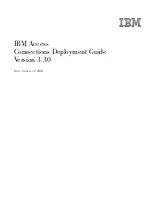
Capitalizing
on
new
profile-deployment
capabilities
to
ease
administration
Access
Connections
has
a
feature
to
make
location
profile
deployment
centrally
manageable.
Prior
to
having
this
capability,
all
client
users
were
required
to
set
up
their
own
location
profiles.
Although
Access
Connections
software
leads
you
through
the
steps
needed
to
create
a
profile,
the
entry
of
settings,
especially
settings
associated
with
security,
can
still
be
cumbersome.
Now
an
IT
administrator
can
do
the
following:
v
Create
location
profiles
and
distribute
them
as
part
of
a
hard
disk
image
or
send
the
profile
files
to
client
systems
that
have
already
been
deployed,
thereby
saving
users
from
spending
time
individually
setting
up
profiles.
v
Control
policies—such
as
whether
a
distributed
profile
can
be
modified
or
deleted—for
all
profiles
in
the
system,
which
could
prevent
users
from
inadvertently
modifying
or
deleting
a
profile
and
then
needing
help-desk
support.
v
Establish
rules
to
limit
users
who
can
import
various
deployment
packages
using
distribution
control
lists
(selectively
distribute
the
profiles
based
on
ThinkPad
serial
numbers).
v
Create
secure
profile
deployment
packages
that
are
encrypted
and
password
protected
so
only
authorized
individuals
can
import
the
location
profiles.
This
feature
is
important
because
profiles
may
contain
wireless
security
content
such
as
a
WEP
key
or
WPA
TKIP
PSK
(Wi-Fi
Protected
Access
Temporal
Key
Integrity
Protocol
Pre
Shared
Key).
A
standard
installation
of
Access
Connections
software
does
not
include
the
profile
distribution
capability.
The
feature
must
be
enabled
using
a
separate
software
tool.
This
enabler
utility
is
available
to
IBM
customers
from
a
dedicated
Web
site
for
registration
and
download.
The
enabler
creates
an
additional
menu
item
in
the
Access
Connections
user
interface
called
Profile
Distribution.
It
is
from
this
profile
distribution
menu
item
that
the
IT
administrator
creates
profiles
to
be
distributed
and
establishes
appropriate
user-access
policy.
If
a
selected
profile
contains
a
wireless
profile
with
encryption
enabled,
the
administrator
will
be
prompted
to
re-enter
the
wireless
security
settings
to
be
deployed,
thus
ensuring
that
the
administrator
knows
the
security
settings
such
as
the
WEP
encryption
key.
If
the
wrong
WEP
key
is
entered,
that
WEP
key
will
be
deployed
but
not
usable.
With
the
profile
deployment
capability,
Access
Connections
software
provides
a
significant
benefit
to
IT
administrators
in
terms
of
wireless
security
manageability.
Many
organizations
that
use
WEP
security
leave
their
WEP
encryption
keys
static
simply
because
the
updating
of
WEP
keys
across
the
entire
client
user
base
is
a
daunting
task.
This
practice
can
put
an
organization
at
risk
because
static
WEP
key
encryption
can
be
broken.
The
Access
Connections
profile-deployment
feature
enables
system
administrators
to
remotely
change
and
deploy
new
security
settings
including
WEP
keys.
By
frequently
changing
WEP
keys,
system
administrators
can
dramatically
reduce
the
possibility
of
security
breaches
in
a
WLAN
environment.
IBM
Access
Connections
software
facilitates
fast,
easy
network
connections
by
using
profiles
to
define
the
network
adapter
and
associated
networking
parameters
for
different
locations.
Easy
to
use
and
manage,
Access
Connections
software
delivers
a
comprehensive
network
connectivity
solution
to
help
you
improve
total
cost
of
ownership
and
employee
productivity.
And
with
the
Access
Connections
software
profile
deployment
feature,
a
system
administrator
can
centrally
create
profiles
and
remotely
deploy
them
to
the
client
user
base—as
opposed
to
setting
Chapter
2.
Using
Access
Connections
7
Содержание IBM Access Connections 3.3.0
Страница 1: ...IBM Access Connections Deployment Guide Version 3 3 0 Date October 11 2004 ...
Страница 4: ...iv IBM Access Connections Deployment Guide Version 3 3 0 ...
Страница 6: ...vi IBM Access Connections Deployment Guide Version 3 3 0 ...
Страница 16: ...10 IBM Access Connections Deployment Guide Version 3 3 0 ...
Страница 26: ...20 IBM Access Connections Deployment Guide Version 3 3 0 ...














































